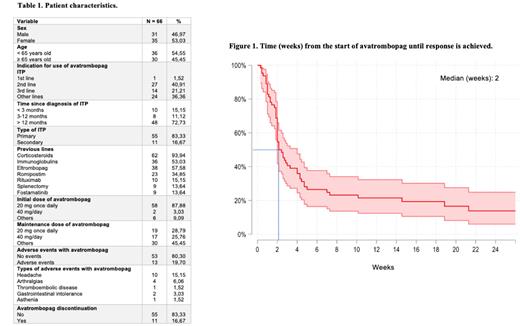Introduction
Thrombopoietin receptor agonists (TPO-RAs) are recommended as second-line treatment for immune thrombocytopenia (ITP) according to the Spanish ITP group (GEPTI) guidelines. Avatrombopag (AVA) is an oral TPO-RA, recently launched in Spain, for which we have little data available beyond the pivotal trial. The main objectives of our study were to evaluate the efficacy and safety of AVA in patients with ITP.
Methods
In this observational, retrospective, multicenter study in 10 hospitals in the Community of Madrid, we have analyzed adult patients with ITP treated with AVA from July 2022-May 2023. Demographic characteristics, response, rescue therapy, adverse effects and treatment discontinuation were analyzed. The definition of ITP and response were those described by Provan et al. The study protocol was designed and applied in accordance with the principles of the Declaration of Helsinki. Statistical analysis was performed using IBM SPSS Statistics v28.0. Fisher and Mann-Whitney tests were used for bivariate analysis and Kaplan-Meier curves for response time.
Results
A total of 66 patients were included. The median age was 52 years old (IQR 34-71). Table 1 describes the general characteristics. There was a median of 2 (IQR1-3) previous lines of treatment before starting AVA. The reasons for its initiation were: refractoriness to previous treatment and/or corticodependence in 39% (25/66), loss of response in 34% (22/66), switch due to patient preference in 14% (9/66) and switch due to adverse effects with previous treatment in 5% (3/66). In 8% (5/66) there was more than one reason for change. The previous line of treatment is described in Table 1.
The median platelet count at baseline was 36x10 9/L(IQR 13-61).
With a median follow-up of 16 weeks (IQR 8-28), 86% of the pateints (57/66) were responders. 73% had complete response. 24% percent (16/66) required salvage therapy. In the bivariate analysis, 100% of those aged ≥65 years presented response vs. 75% in <65 years (p=0.003). A complete response was achieved in 88.6% of women versus 54.8% of men (p=0.002). Patients with complete response received fewer lines of treatment (1 [IQR 1-3] vs 3.5 [IQR 2-6]); p< 0.001). Complete response was achieved in 60.5% of patients who received previous treatment with eltrombopag (p=0.01), in 47.8% of those with romiplostim (p<0.001), in 40% with rituximab (p=0.02), in 33.3% with splenectomy (p=.0.01) and in 22.2% with fostamatinib (p=0.00).The median time from initiation of AVA to response was 2,1 weeks [IQR 2-4] (Figure 1). Twelve patients (18%) discontinued AVA due to: lack of response (n=6), adverse effects (n=3), one patient prior to scheduled surgery, and In these patients AVA was restarted with dose adjustment. Adverse effects are described in Table 1.
Conclusions
The results of the use of AVA in real-life demonstrated a high response rate, more favorable in the initial lines of treatment. In addition, it reduces the need for salvage therapy and has a low adverse effect profile. A larger number of patients and a longer follow-up are needed to verify these results and to answer some questions such as whether it is possible to discontinue AVA treatment after response and the percentage of patients with sustained response following AVA discontinuation.
Disclosures
No relevant conflicts of interest to declare.


This feature is available to Subscribers Only
Sign In or Create an Account Close Modal